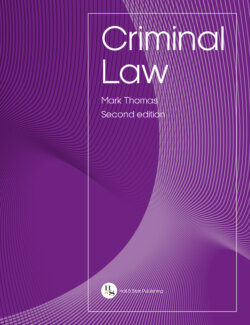Читать книгу Criminal Law - Mark Thomas - Страница 45
На сайте Литреса книга снята с продажи.
Standard of proof
ОглавлениеIn criminal cases, the standard of proof refers to the level or degree of proof that must be established. Two standards of proof exist, namely:
•the criminal standard: ‘beyond a reasonable doubt’; and
•the civil standard: ‘on the balance of probabilities’.
The criminal standard is expressed as a requirement to satisfy the burden of proof ‘beyond a reasonable doubt’. This standard is quite often expressed as ‘a’, ‘all’ or ‘any’ reasonable doubt and has been defined by Lord Denning in Miller v Minister of Pensions [1947] 2 All ER 372 as follows:
It need not reach certainty, but it must carry a high degree of probability. Proof beyond reasonable doubt does not mean proof beyond a shadow of a doubt. The law would fail to protect the community if it admitted of fanciful possibilities to deflect the course of justice. If the evidence is so strong against a man as to leave only a remote possibility in his favour which can be dismissed with the sentence, ‘of course it is possible but not in the least probable’, the case is proved beyond reasonable doubt but nothing short of that will suffice.
This criminal standard applies in all criminal trials, whether before magistrates or on indictment before a jury, and if there is a reasonable doubt created by the evidence adduced either by the prosecution or by the defence, the prosecution has not made out its case and the burden is not satisfied. The criminal standard has also been expressed over the years in terms of ‘so that the jury are “sure”’ (R v Majid [2009] EWCA Crim 2563). In R v Folley [2013] EWCA Crim 396, the Court of Appeal expressed these two terms as synonymous with each other.
The civil standard is expressed as a requirement to satisfy the burden of proof ‘on the balance of probabilities’. Lord Denning offered a definition of this term, also in the Miller case, as: ‘If the evidence is such that the tribunal may say “we think it is more probable than not” the burden is discharged, but if the probabilities are equal it is not.’ In a similar vein, the Court of Appeal in R v Carr-Briant [1943] KB 607 reasoned that the burden of proof will be discharged where the arbiters of fact conclude that it is ‘more likely than not’ that the fact existed.
The correct ‘use’ of the standard of proof depends on the party who bears the particular burden of proof. This is detailed in Table 1.7.
Table 1.7The appropriate standard of proo f
| Where the burden is on the … | The standard is… |
| Prosecution | ‘Beyond a reasonable doubt’ |
| Defence | ‘On the balance of probabilities’ |
